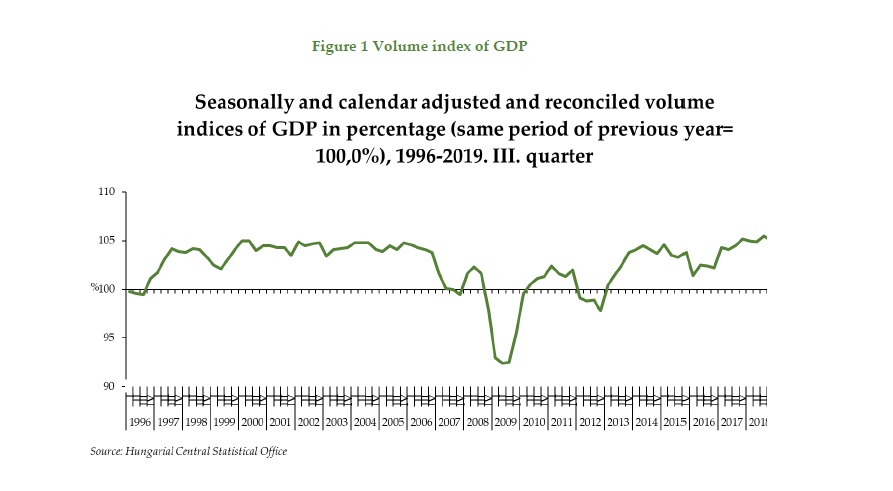Macroeconomic trends in Hungary
Hungarian economic tendencies will be presented in the article below via an overview of the most important macroeconomic indicators such as GDP, employment, gross wages, investments, industrial production and foreign trade, from directly after the crisis to 2019.
In 2009 the Hungarian economy found itself in a remarkably deep crisis. The recession was almost as severe as the transformational crisis (1991-1995) caused by the regime shift. The crisis resulted in plummeting economic performance - GDP fell 6.5% by the end of the year 2009. This downward tendency slowed down in the first half of 2010, turning into growth in mid-2010, and in the second half of the same year the growth rate was back at the pre-crisis level. Then in 2011, owing to the crisis of the Eurozone, the international economic environment became quite unfavourable again.
The Hungarian economy relapsed in 2012, with GDP dropping by 1.5%. Finally, recovery came in 2013 with a growth rate of 2.2%, and the next year saw a 4.1% growth year-on-year. There was a mild slowdown in 2015 and 2016 with growth rates of 3.5% and 2.2% respectively, followed by a surge to 4.1% in 2017. 2018 was a top year when GDP growth shot up to 5.1%. The first three quarters of 2019 saw similar growth rates. In the first two quarters, economy grew by 5.2%, and in the third quarter the rate was somewhat lower at 4.8% compared to the same period of the previous year.
Recovery after the crisis was much slower in Hungary than in its number one target country for exports, Germany. On all accounts, the Hungarian crisis was much deeper than the one Germany had to recover from. Furthermore, recovery in Hungary could only start later than in Germany. Although recession affected the two economies at an equal strength and at an equal speed, in the first quarter after the turning point in 2009 the German economy could recover remarkably quickly. By early 2011 the German economy had been back at pre-crisis levels and has grown almost unintermittently ever since. Hungary, on the other hand, had to deal with a prolonged recession, only reaching pre-crisis levels in the third quarter of 2014. The growth rate difference between the two economies levelled out between the first quarter of 2016 and the fourth quarter of 2017, and in 2018 the Hungarian growth rate spiked up and overtook that of Germany. In 2019 the Hungarian growth rate difference was 6-7% over Germany.
To read further, click on the attached document below
